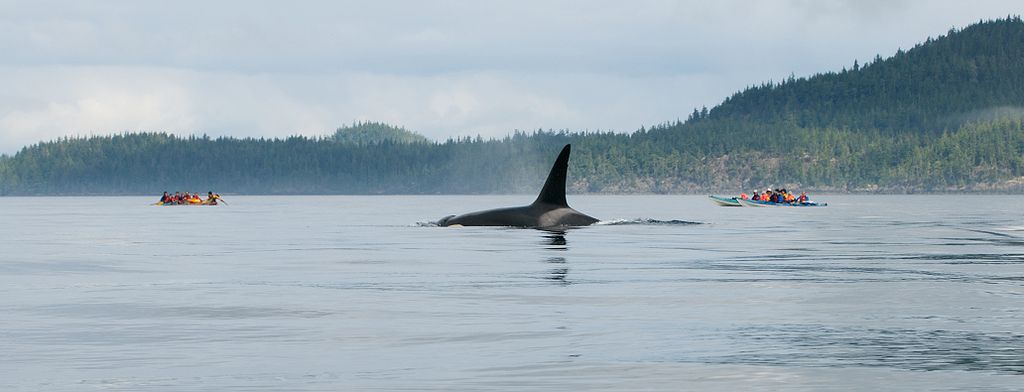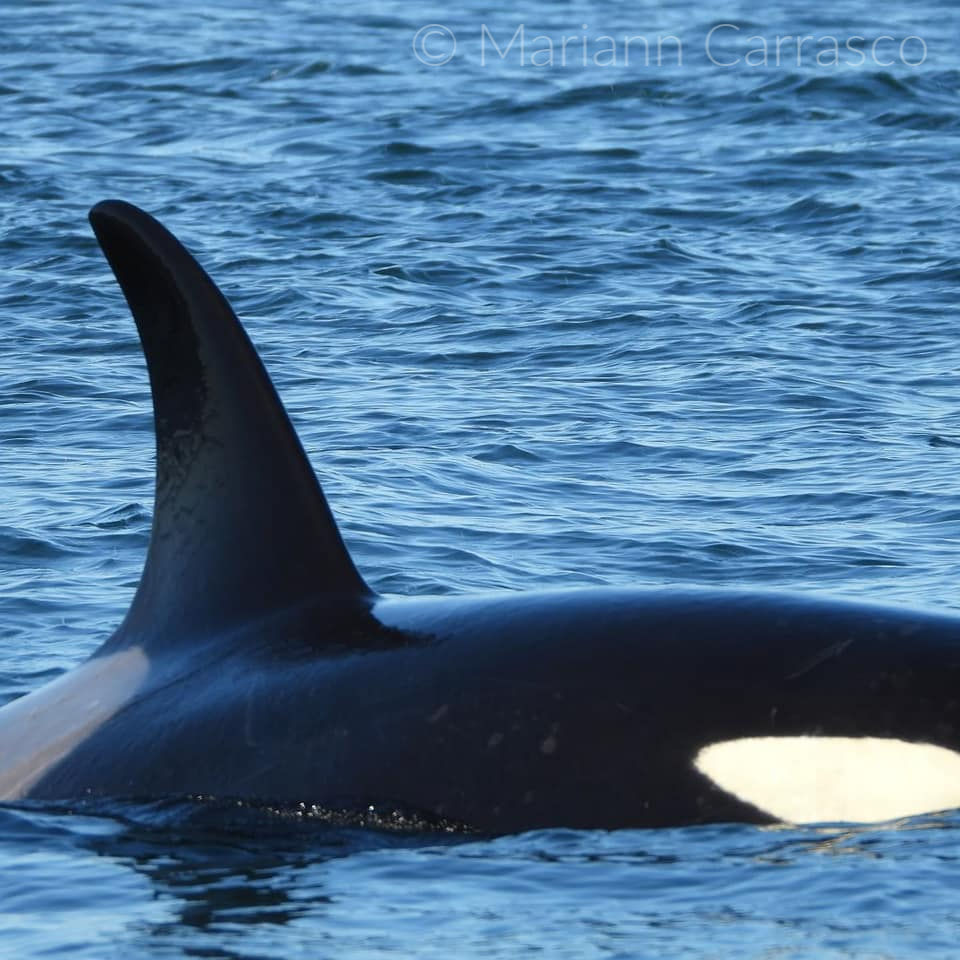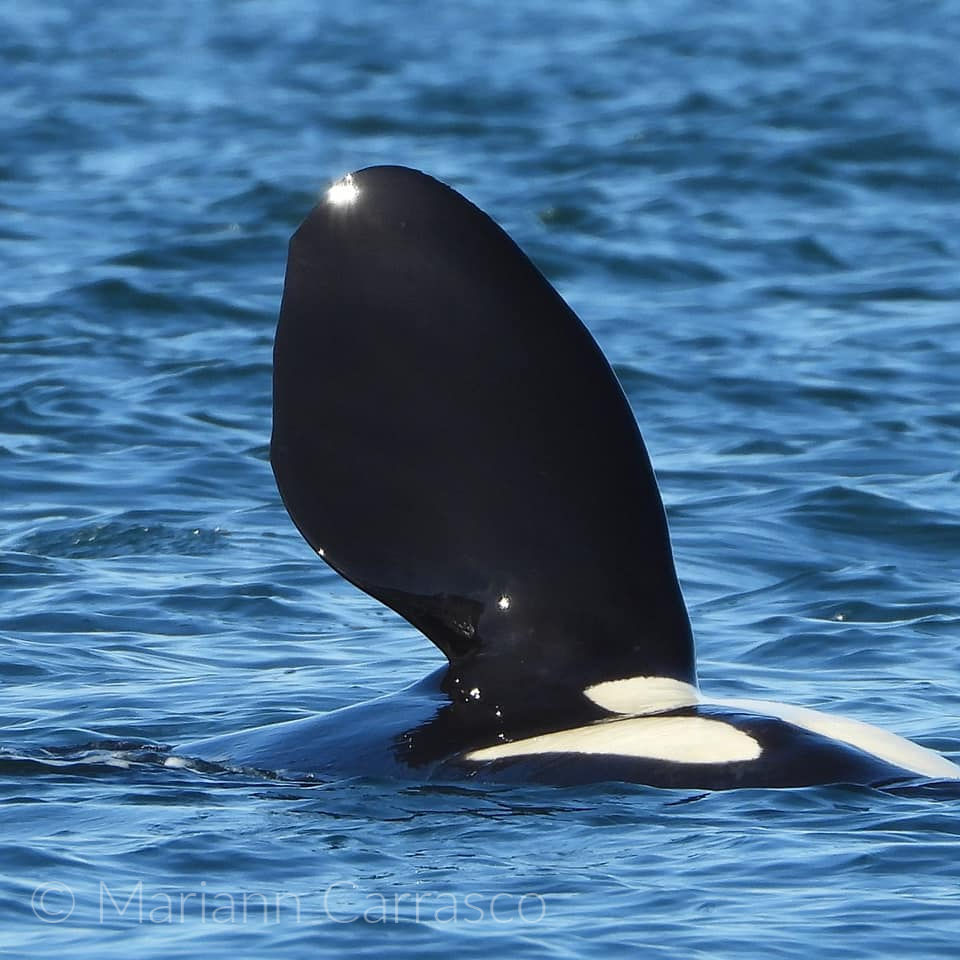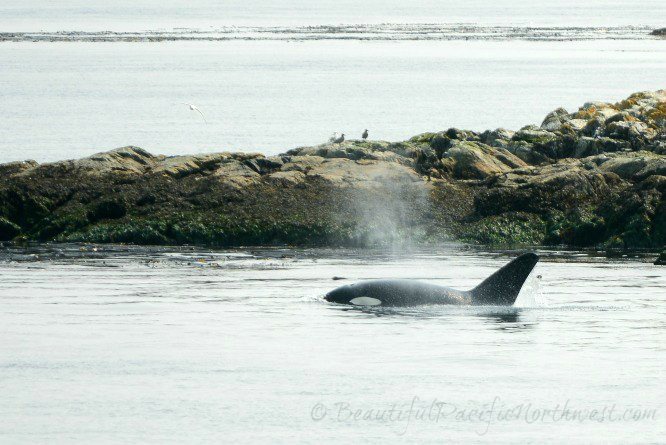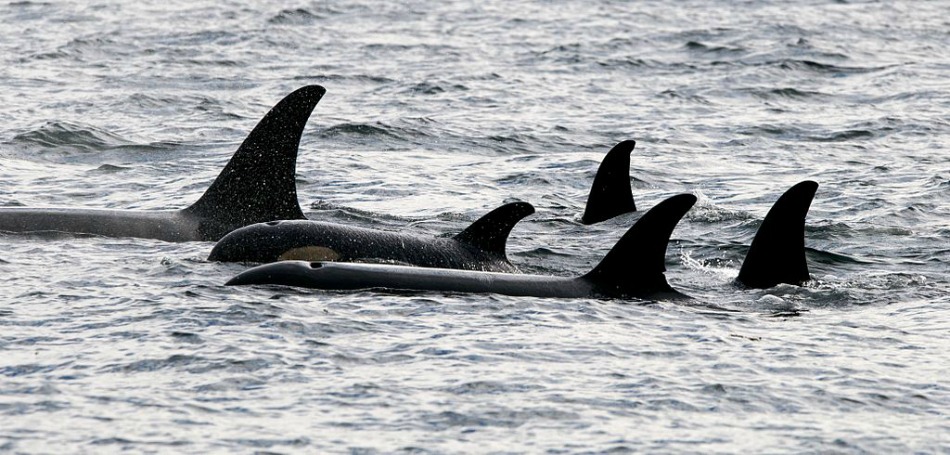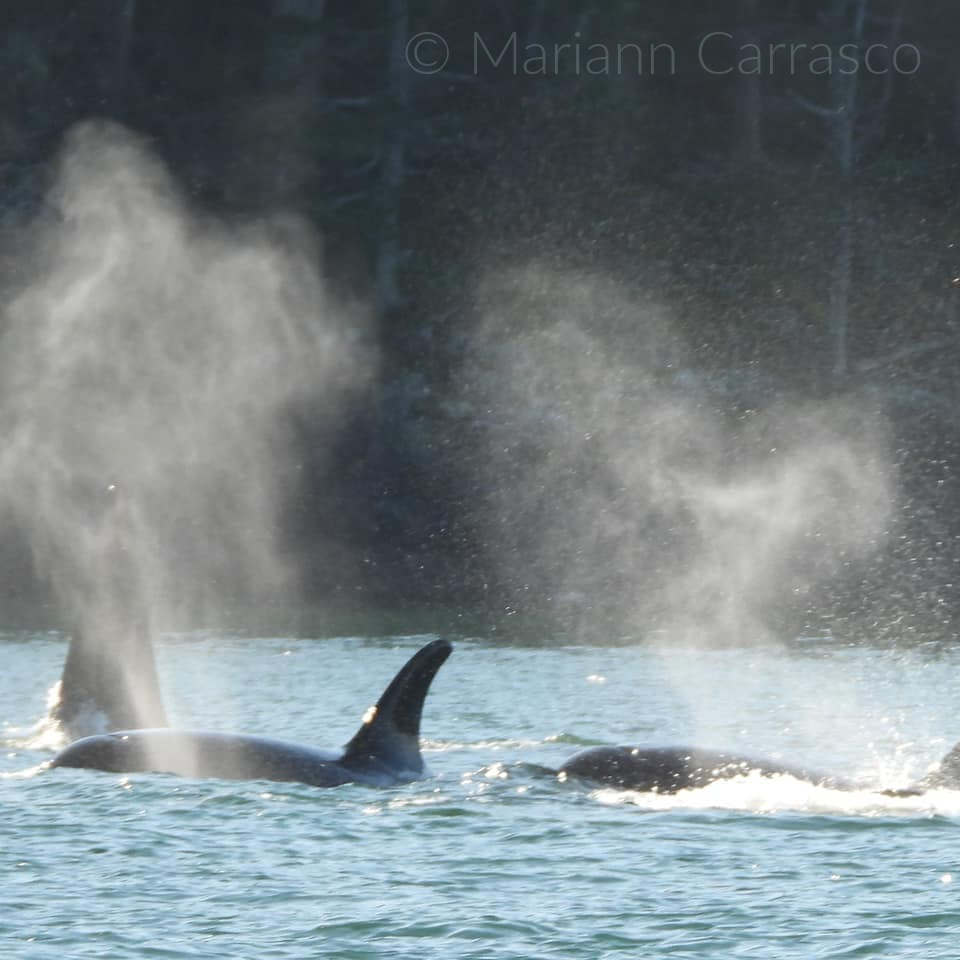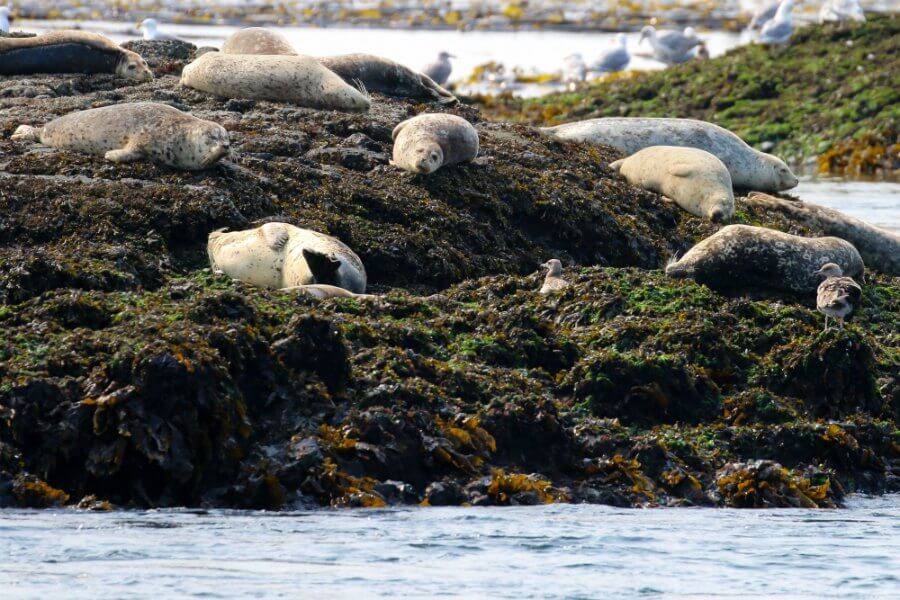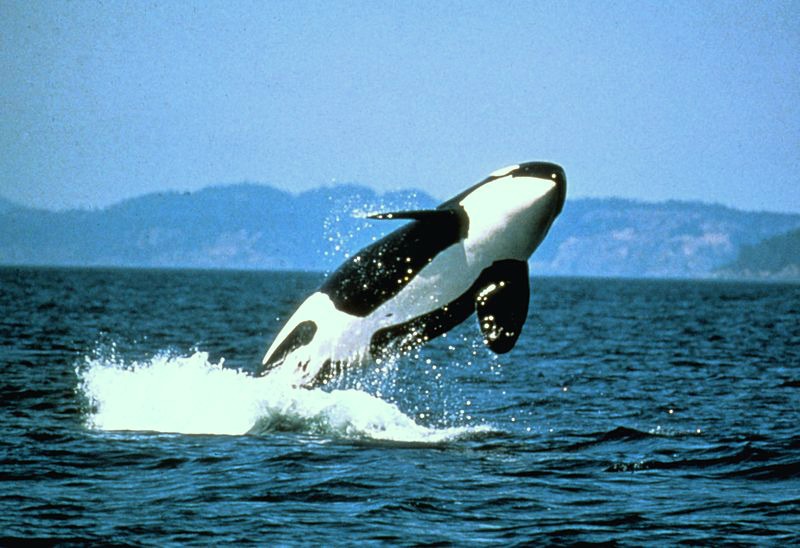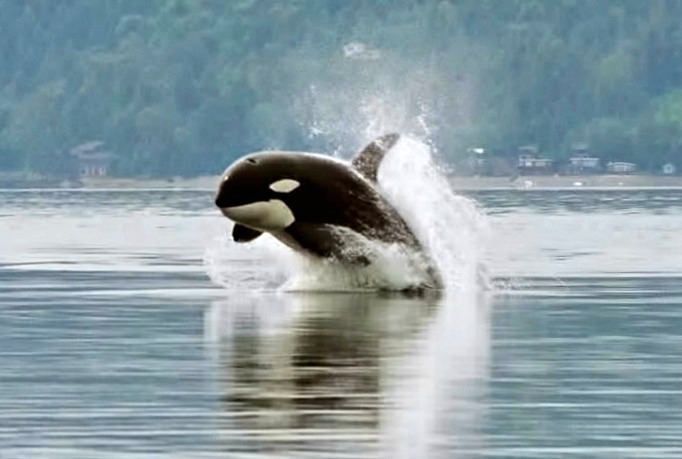Orca Whales
Orca whales. Info, descriptions, and photos of the orca, or killer whale, icons in the Pacific Northwest, plus links to whale watching cruises.
One of the beauties of the Northeast Pacific Ocean is the Orca whale (a.k.a. Killer Whale).
Widely recognized for its distinctive black and white markings, the Orca is found in all oceans, and is considered common along the coast of Washington, Oregon and British Colombia. In fact, the Orca is the most widely distributed mammal in the world, after humans.
The most studied group of killer whales are quite possibly the resident groups found right here in the coastal waters of the Pacific Northwest. Most of what scientists have learned about this species of whale comes from studying our local Orca whales.
Below - Photo Credit: Wikimedia
These include three groups of Orcas: Resident, Transient, and Offshore. The “Southern Resident” population, which makes its home in the coastal waters of British Columbia and Washington are the only known population of Orca to be considered “U.S. killer whales," and are currently listed on the United States Endangered Species List.
Take a Whale Watching Tour!
Whale watching is a favorite pastime in the Pacific Northwest, and seeing orca whales may be a highlight of whale watching cruises.
Catch a tour from:
This page about orca whales and our humpback whale facts page are intended to enhance your whale watching experience. Enjoy!
Identify those Orca Whales
There are 3 full-time resident orca whale pods living in the Pacific Northwest. Known as "J," "K," or "L," pods, they make up one community totaling about 85 individuals. (Numerous transient individuals pass through seasonally increasing the population by about 250.) Each resident whale is named with a letter, for the pod they belong to, and a number which designates the order in which they were identified. For example: K20 was the 20th whale to be identified as belonging to the K-pod.
Considered by whale lovers to be extended family members, whales are also given nicknames, for example K-26 is known affectionately as Lobo, K-38 is Comet and J-2 is called Granny. (Granny, who was estimated to be around 103 years old in 2013, has since disappeared and is believed to have died.)
Go here for photos of orcas by their number and names.
Wouldn't it be fun, when you spot an orca in the wild, to be able to identify it by both name and number?!
Below: These orcas are members of J-Pod. They were photographed just outside of Friday Harbor by Mariann Carrasco.
The Orca Whale in Legends and Mythology
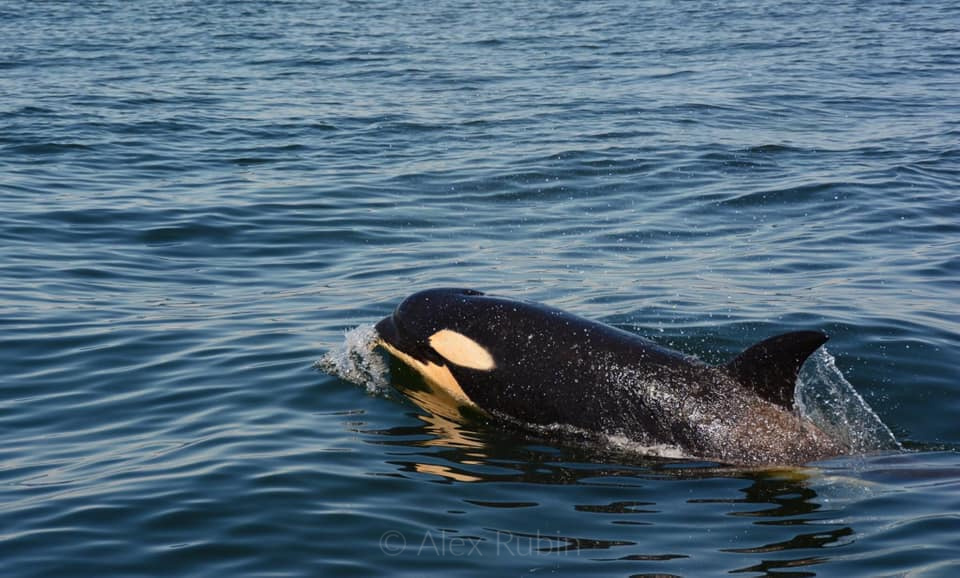 Young orca whale swims in the Salish Sea off the coast of the San Juan Islands. Photo Credit and many thanks to photographer Alex Rubin.
Young orca whale swims in the Salish Sea off the coast of the San Juan Islands. Photo Credit and many thanks to photographer Alex Rubin.The Pacific Northwest is rich in Native American influence and history. So it is no surprise that a majestic creature such as the orca, so easily found off the coast, would hold a significant place in local indigenous cultures.
In fact, one does not have to go very far to find the orca used in Native sculptures, paintings, even totem poles. Along with these unique artistic expressions are legends and myths involving the orca whale that go back many generations.
How the Orca was Created, according to Tlingit Legend
Natsilane was a talented wood carver among the Tlingit*, who married the Chief's daughter. His new brothers-in-law, driven by jealously over Natsilane's skill, came up with a scheme to take him along on a traditional sea lion hunt and then abandon him to die at sea.
Stranded in the middle of nowhere on a small rock, Natsilane saw a sea lion beckoning to him underwater. The sea lion's son had been injured by a spear during the hunting trip, and he asked Natsilane to heal him. After removing the spear, Natsilane was rewarded with special powers by the Sea Lion Chief, and helped back to shore.
Still feeling angry about being left to die at sea, Natsilane began to carve a whale using different types of wood. The first two whales were simply carried away by the waves, but the third, carved from yellow cedar, came alive. Immediately, Natsilane sent it to take vengeance on his brothers-in-law. The killer whale found them, destroyed their canoe, and killed them all. But Natsilane soon regretted his decision, and upon returning to him, he told the whale not to hurt any human ever again.
And That is Why Orcas Don't Attack Humans
Orcas in the wild seem to have no desire to prey on humans, and the Tlingits noticed this. Besides attempting to describe the creation of orcas, their legend also attempts to answer the question, "Why don't killer whales prey on humans?"
While science has not been able to answer this question for certain, observation has revealed that this question may have multiple explanations. Among the possibilities, three likely answers exist:
- Orcas have their own unique “culture,” which include special “greeting ceremonies,” as well as a ritual resembling a funeral. These interactions suggest that it's possible preying on humans is simply not a “social norm” for killer whales.
- Another idea is that we are not “on the menu” due to a lack of tastiness, since the Orca's palate is actually quite picky.
- Lastly, it's possible that because we don't resemble any other natural food source for the Orca, they don't see humans as food. Reports have surfaced of an attempt by a killer whale to hunt a human, but upon discovering the prey was not actually the sea lion it thought it was, broke off the hunt.
The only documented attacks on humans have occurred from killer whales in captivity, such as in large aquariums. Many experts agree that when these outbursts have happened, the animals are not actually trying to be violent, but are simply taking play a little too far.
However, the argument is still made by some that the attacks are in fact, on purpose, a result of being taken from their pods, housed in a tank, and being fed by hand, as opposed to hunting in the wild.
Local Native American Names for Orca whales
- Max’inux – Kwakiutl tribe, located in northern Vancouver Island
- Ska-ana – Haida tribe, located on the Queen Charlotte Islands
- Qaqawun - Nootka tribe, located in western Vancouver Island
- Klasqo’kapix – Makah tribe, located on the Olympic Peninsula
- Ka-kow-wud – Quillayute tribe, located on the Olympic Peninsula
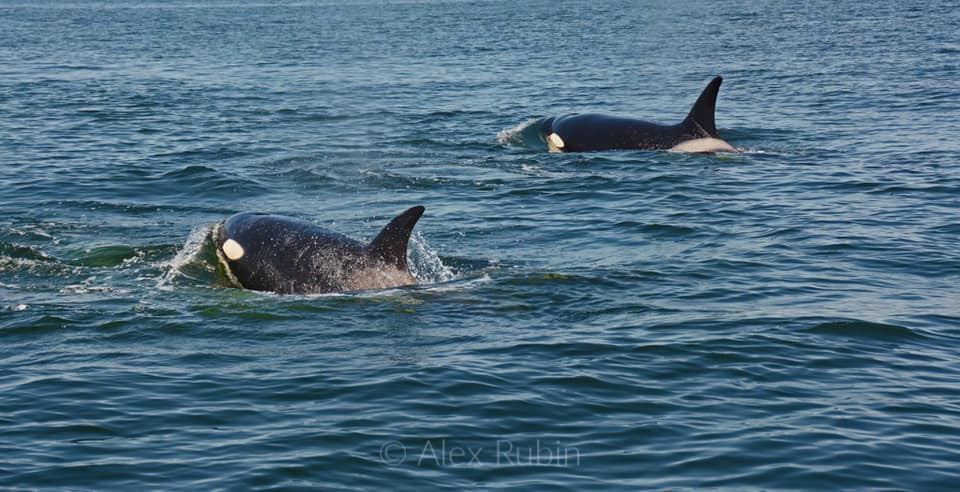 Orca whales cruising along the Salish Sea not too far from Port Angeles, WA.
Orca whales cruising along the Salish Sea not too far from Port Angeles, WA. Photo Credit and many thanks to photographer Alex Rubin.
Physical Characteristics of the Orca Whale
Orcas are classified as toothed whales, or Odontoceti, having anywhere between 20 to 26 pairs of large, interlocking teeth. Their teeth curve backwards, as well as in, which is helpful in catching dinner. On average, an orca tooth is 3 inches long and about 1 inch around.
The Orca whale is the largest member of the dolphin family.
- Males range from 23 to 30 feet (7 - 9.1 m) long and weigh at least 6 tons (5443 kg).
- Females are generally smaller, ranging from 20 to 26 feet (6.1 - 7.9 m) in length and weigh about 3 to 4 tons (2,722 - 3,629 kg).
- At birth, calves weigh about 400 pounds (181 kg) and are about 7.9 feet (2.4 m) long.
The cylindrical shape of the body is perfect for diving and catching prey, as it allows for less drag in the water.
The killer whale possesses good eyesight, as well as excellent hearing; but when hunting, these creatures won't be following their nose – they have no sense of smell.
The orca has three different types of fins:
- Pectoral fins are used for steering
- The dorsal fin gives stability when traveling at higher speeds.
- Flukes, located on the tail, help the orca stop
Below - Photo credit: Wikimedia
Reproduction and Breeding
Female orca whales reach sexual maturity around age 10, and their breeding years end at around age 40. They will have raised 5 young, on average. Males mature around age 15, but often do not reproduce until age 21.
Orcas breed in winter to early spring, in warmer waters and near the surface. The gestation period lasts about 16-17 months. Typically, a mother will birth a single calf about once every 5 years.
Calves are born between the months of October and March, tail first, near the surface of the water. Within the first 10 seconds of birth, the newborn swims to the surface to take its first breath, helped by its mother. 30 minutes later, the calf can fully swim on its own. Calves will nurse several times an hour for only 5 to 10 seconds at a time.
The average lifespan for a female in the wild is 50 years, but she might also live up to 80–90 years. Males live an average of 29 years in the wild, with a maximum of 50–60 years.
Diet
An orca's diet is quite diverse, and can vary between distinct groups. Some orca populations feed only on fish, while others prefer to feed on other marine mammals. Their diet may include fish, seals, penguins, rays, even sharks. In fact, worldwide, scientists have observed orcas feeding on 140 different types of prey.
Ironically, orca whales are actually a picky eaters. The Southern Resident killer whales located in the Puget Sound have been observed allowing entire schools of salmon to pass by untouched, because they weren't fatty enough for their taste. Transient whales, though they enjoy a broader diet, were once spotted hunting a grey whale, though in the end ate only its tongue!
Social Activity
If you go whale watching and come across an individual orca pod, notice that it is always be led by a single female matriarch. The family group consists of her children and grandchildren.
Even a male killer whale will stay within the family, leaving only for a few days at a time to mate with females of a different pod. But he will always come back home. In fact, a male killer whale has such a bond to his mother that he will spend at least 40% of his time within a body length of her. The benefit to his mom? He makes a great “babysitter” for any younger siblings.
Like many whales, orcas use echolocation to detect the whereabouts of prey, and the characteristics of that prey. They can produce three different types of sounds: clicks, whistles, and pulsed calls. These sounds are not merely for hunting, but allow the whales to communicate with one another using distinct changes in tone, and rate of pulses. Remarkably, each pod has its own dialect that is unique to them!
Below - Photo Credit: Wiki
* The indigenous people group known as the Tlingit make their home along the coast of Southeast Alaska and down through British Columbia, Canada. Their name means: "People of the Tides."
Have you Gone Whale Watching?
Please Share Your Stories and Photos With Us!
Please Share Your Stories and Photos With Us!
Whale watching can be a spectacular, awe-inspiring experience! We'd love hearing about your whale watching happenings here on our website. Please share your stories along with some exceptional photos if you have them. We know that other visitors will enjoy these stories and seeing the photos as well!
Just click into the title box below and go from there. When published, you'll have "your own" page on MyPortAngeles which you can share with friends or anyone who asks!
We're happy to ensure professional and amateur photographers get credit for their work. Leave us your name in the form below, and means of contact, website, or FB page info so we can link back to you.
